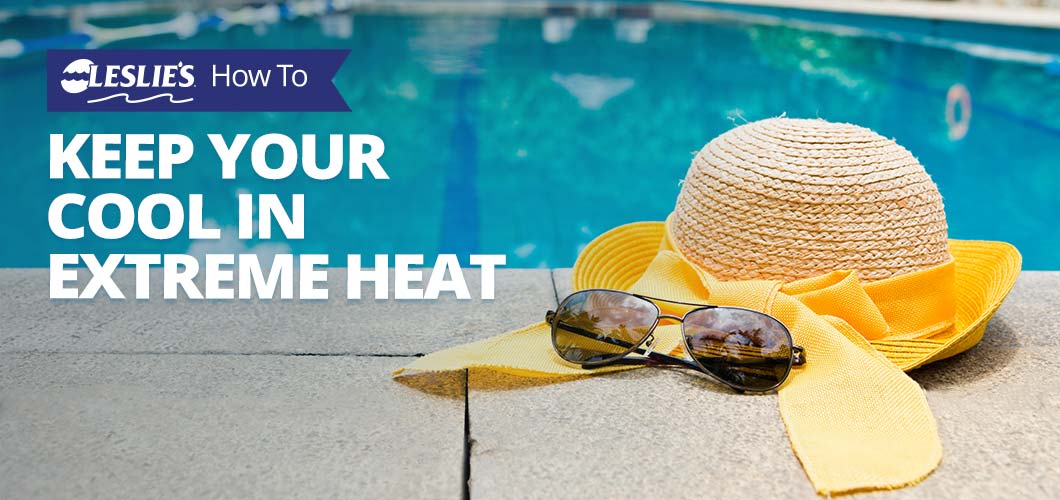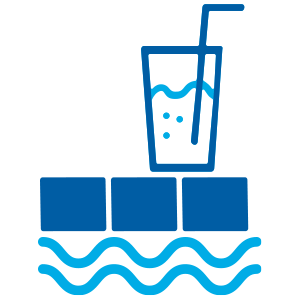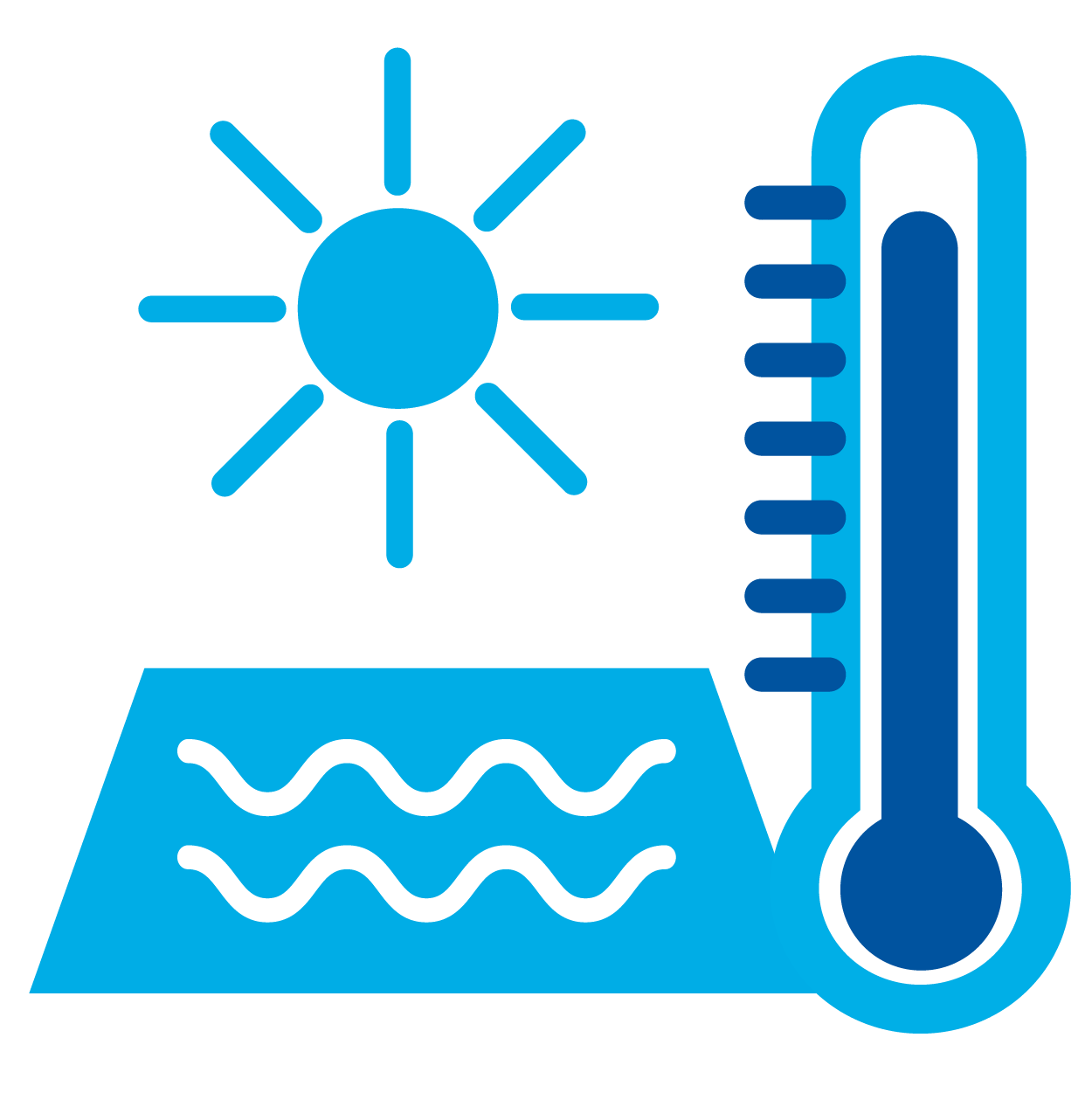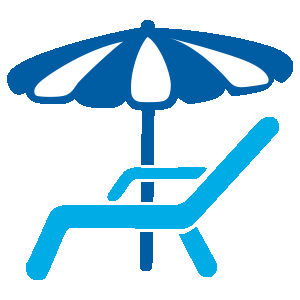
How to Keep Your Cool in Extreme Heat
People often dream of having an endless summer. But the reality is that ever-rising temperatures can make fun in the sun a challenge. As the unrelenting sun shines down on your backyard, the importance of preparation in the face of extreme temperatures has never been higher. That said, the ruthless summer sun doesn’t need to ruin your next pool party. With a few simple precautions, you can stay safe and keep on swimming through all the toasty weeks to come.
Pool Preparation
Extreme heat can negatively impact your pool chemistry if left unattended. When the ultraviolet rays of the sun hit your water, they break apart the hypochlorite ions created by chlorine and release chlorine gas into the air. Sunlight alone can reduce the chlorine level of your pool by up to 90% in just a few hours! Most professionals recommend using a chlorine stabilizer to extend the life of your chlorine and stave off the effects of UV rays.
BONUS TIP: To see if you need more stabilizer or conditioner in your pool, test the water for Cyanuric Acid (CYA). Levels should stay between 30–50 ppm for optimal chlorine performance in a chlorine pool.

In addition to the sun’s UV rays, rising temperatures also have a profound effect on pool chemistry. Extreme heat leads to chlorine getting used up faster, which can cause unsanitary and unsafe swimming conditions. Because it’s easier for algae and bacteria to grow in warmer environments, chlorine levels can drop quickly, as it works to fight off living contaminants in the water. Left unchecked, low chlorine levels can quickly lead to murky, filthy water.
During periods of extreme heat, it's important to test your pool water for Free Available Chlorine (FAC) levels on a regular basis. The ideal range for your FAC is between 2.0 and 4.0 ppm (parts per million). This number should stay close (if not identical) to Total Available Chlorine (TAC) levels. Should your FAC reading fall more than 0.3 ppm below the TAC level, or if the FAC level drops below the ideal range, it’s important to shock the pool immediately to keep it clean, clear, and safe through the hot summer months.
Summertime Safety
Under extreme heat, your chlorine level isn't the only thing taking a beating. Rising temperatures leave you at risk of sunburn, heat stroke, and heat exhaustion! No pool party is worth risking your safety over, so take proper precautions before venturing outdoors.
Heat Stroke and Heat Exhaustion

First and foremost, recognize the signs that you might be experiencing heat stroke or heat exhaustion. Heat stroke is caused by your body overheating. It increases your heart rate, makes your skin dry to the touch, causes headaches, and can even induce nausea and vomiting. Heat exhaustion is similar, but the symptoms are markedly different. It causes a slower heart rate, heavy sweating, and clammy skin.
As with most things, prevention is the best cure for heat stroke and heat exhaustion. Relax in shaded areas, drink plenty of water, and only wear lightweight clothing. If you or someone nearby appears to be experiencing heat exhaustion, move them into air conditioning, apply cold compresses or a cool cloth, and offer something to drink. If they're showing signs of heat stroke, call 911 immediately, and move them somewhere cooler while you apply cold compresses.
Dehydration

Dehydration is also a serious threat in the heat. It's best recognized by feelings of dizziness, fatigue, and extreme thirst. It’s easy to forget to stop for a drink of water while having fun in the pool. But taking regular breaks to cool off and rehydrate will go a long way toward keeping you safe. Keep cold refreshments readily available, and stop for a drink every 20–30 minutes, minimum.
Sunburns
You likely don’t need to be reminded to use sunscreen to prevent sunburns in the summer. However, it’s important to remember how often sunscreen needs to be applied. Even when the weather is cloudy, the risk of sunburn during periods of extreme heat is ever-present. Reapplying your sunscreen over the course of the day is a must! Sunscreen loses its effectiveness over time, and can wash off in the water.
Cool Your Pool

Drinking water and staying in the shade will keep you cool. But did you know there are ways to cool down the swimming pool itself? The simplest, most cost-effective way to keep your pool a few degrees colder is to run your pump at night, when the air is cooler. The effect won’t be drastic, but this should still make a noticeable difference.
Another effective way to cool your pool is to install a reverse-cycle heat pump. That may sound counterintuitive, but many heat pumps have the power to run reverse cycles that take heat out instead of only pumping it in. As such, a reverse-cycle heat pump is a great investment for both extreme heat and cooler weather. Once summer's over, it will extend the number of weeks you can comfortably swim in your pool. Similarly, dedicated pool coolers are also a great way to lower your water's temperature and give you perfectly chilled pool water.
Finally, the most entertaining way to cool your pool in extreme heat is to install a waterfall or fountain. Adding a bit of air to your water and keeping it circulating can make a big difference in how refreshing your pool feels. Whether you install a fountain, a waterfall, or even a pool slide, it’s hard to go wrong with any moving water features. Just keep in mind that moving, aerated water can increase evaporation, raise pH levels, and increase the rate of chlorine loss. Looking for more pool cooling tips? Check out our other blog post, How To Cool Your Pool in the Summer.
BONUS TIP: If you're not looking to make modifications or add equipment to the pool, just use a sprinkler. Place it by the pool edge to help with refill, or set it up in the yard for a different kind of play. Sprinklers are especially fun for young children and groups. All you have to do is connect a garden hose, and you're all set!
Beat the Heat

Extreme heat can ruin your summer fun in a hurry. But with a few simple precautions, staying safe and cool in the pool has never been easier. Checking and adjusting the Free Available Chlorine levels in your water takes only a few minutes each day. Everyone should always use sunscreen and drink plenty of water, even while swimming in the pool. When temperatures rise to the extreme, it’s possible to cool down the water itself and keep your swimming pool from becoming a hot tub. If you still need help beating the heat, stop by your local Leslie’s. From chlorine and cooling options, to fun sprinklers and patio umbrellas, our pool solutions can help you spend less time worrying about the heat and more time making a splash!